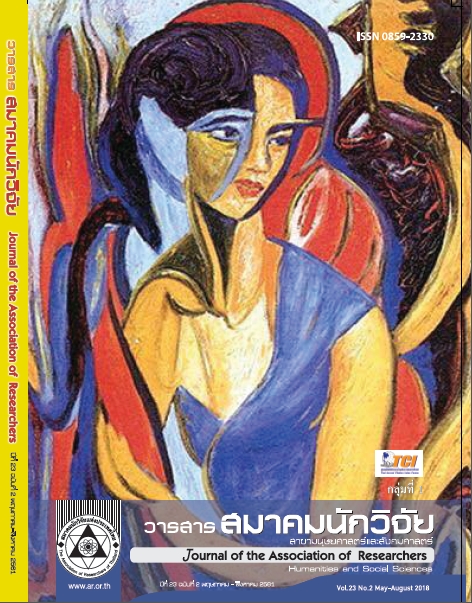Collaboration on Soil and Water Conservation Using Vetiver Grass
Main Article Content
Abstract
A study on the “Collaboration on Soil and Water Conservation Using Vetiver Grass” focuses on the following objectives: 1) To study the process leading to the collaboration on soil and water conservation using vetiver grass. 2) To study the results of the collaboration on soil and water conservation using vetiver grass. 3) To propose approaches to advance the development of the collaboration on soil and water conservation using vetiver grass by means of the following research tools: the researcher and conducted structured, in-depth interviews with participatory observation and non-participatory observation. The data was collected from 40 key informants which are: Chaipattana foundation, Office of the Royal development projects board, PTT public company limited, and farmers who took part in the soil and water conservation by using vetiver grass and formed a Vetiver network. The study found that in order to ensure effectiveness of soil and water conservation by using vertiver grass, there should be a well-developed process in creating the collaboration, as well as having the following important factors involved; policy making, planning, communication/interpretation, building of trust and follow-up evaluation. The results were divided into three areas: “the economy”, for strengthening incomes, “the social development”, for creating knowledge, providing source of education and influencing innovation; and “the environment”, for maintaining soil fertility, providing clean source of water and preventing soil erosion. All of which led to these findings that although the government held full authority in the administration and management, as well as having adequate budget, there are yet to be appropriate ways in allocating the resources that could advance the soil and water conservation using vetiver grass. Therefore, the reliability on private sectors and civil society participation is utmost necessary in developing soil and water conservation using vetiver grass. But the government was unable to put effective control over the administration and management of this collaboration and unable to pass down to citizens and farmer. Thus, it requires the collaboration from all sectors in the process of developing a good collaboration as a whole. The proposed recommendations are: 1) for government sectors to establish a policy on soil and water conservation by using vetiver grass as the main agenda for all relevant departments, 2) for any relevant authorities to show support and promote the collaboration between citizens on soil and water conservation by using vetiver grass and for this to widely spread across all regions, 3) The approaches and implementation of the collaboration in conservation of soil and water by using vetiver grass should be conducted in a bottom-up fashion and 4) The citizens should be empowered and enabled to take part in monitoring the follow up evaluation of the following project.
Article Details
บทความที่ปรากฏในวารสารนี้ เป็นความรับผิดชอบของผู้เขียน ซึ่งสมาคมนักวิจัยไม่จำเป็นต้องเห็นด้วยเสมอไป การนำเสนอผลงานวิจัยและบทความในวารสารนี้ไปเผยแพร่สามารถกระทำได้ โดยระบุแหล่งอ้างอิงจาก "วารสารสมาคมนักวิจัย"
References
กรมพัฒนาที่ดิน. (2558). เอกสารโครงการหญ้าแฝกเฉลิมพระเกียรติ “ชนิดของหญ้าแฝก”. กระทรวงเกษตรและสหกรณ์.
ทวีศักดิ์ ธนเดโชพล. (2558). ศึกษาเรื่อง ความร่วมมือในการจัดการภัยพิบัติเพื่อป้องกันและบรรเทาอุทกภัย กรณีศึกษา: จังหวัดชุมพรและจังหวัดสงขลา. วิทยานิพนธ์, ปรัชญาดุษฎีบัณฑิต (รัฐประศาสนศาสตร์), มหาวิทยาลัยรามคำแหง.
วรเดช จันทรศร. (2556). ทฤษฎีการนำนโยบายสาธารณะไปปฏิบัติ. พิมพ์ครั้งที่ 6. กรุงเทพฯ : หจก.สหายบล็อกและการ พิมพ์จำกัด.
วรินทร์ธร ธรสารสมบัติ. (2556). ความร่วมมือระหว่างภาครัฐ ภาคเอกชน และชุมชนในการพัฒนาการท่องเที่ยว. วิทยานิพนธ์, ปรัชญาดุษฎีบัณฑิต (รัฐประศาสนศาสตร์), มหาวิทยาลัยรามคำแหง.
อุทัย เลาหวิเชียร. (2543). รัฐประศาสนศาสตร์: ลักษณะวิชาและมิติต่างๆ (พิมพ์ครั้งที่ 6). กรุงเทพมหานคร: สำนักพิมพ์ เสมาธรรม.
Agranoff, R.,.(2006). Inside Collaborative networks: ten lessons for public managers. Public Administration Review, 66 (6), pp. 33-65.
Agranoff, R., & McGuire, M. (2003). Collaborative public management: New strategies for local governments. Washington, DC: Georgetown University Press. p. 4, 48-53
Chandarasorn Voradej. (2013). Theory of Public Policy Implementation (6th edition). Bangkok: Sahyblock and karnpim limited partnership. (in thai).
Conger, J. A. (2000). Charismatic leadership and follower effects. Journal of Organizational Behavior. p.23
Creswell, J. W. (1998). Qualitative inquiry and research design: Choosing among five traditions. Thousand Oaks, CA: Sage.
Czajkowski. (2006). Critical limits of soil water availability (CL-SWA) for forest trees-an approach based on plant water status. Landbauforschung.vTI Agric, For Res. 59, 87-94.
Greenfield J.C. (1990). Vetiver Grass. The Hedge Against Erosion. 3rd ed. The World Bank,
Washington D.C. Keraminiyage. (2009). Ahuman-computer interaction principles based framework to assess the user perception of Web based virtual research environments. Interational Journal of Strategic.
Koyama. (2010). Interprofessional Collaboration in a Rehabilitation Hospital in Japan. Dissertation, Tokyo, Japan.
Land Development Department. (2558). Vetiver Grass of Honor Project “Vetiver Grass types”. Ministry of Agriculture and Cooperatives. (in thai).
Li. (2012). A Case Study of One Confucius Institute: A China-U.S. University Synergistic Collaboration. Dissertation, Florida, US.
Ostrom, V., & Ostrom, E. (1978). Public Goods and Public Choices. Workshop in Political Theory and Policy Analysis. Indiana University, p.16.
Mattessich et al. (2001). Collaboration: What makes it work. A review of research literature on factors influencing successful collaboration (2nd edn.). Saint Paul, MN: Amherst H. Wilder Foundation.
Peilin Li & Haiying Ma, (2015). An Empirical Analysis of Economic Development in Northwest China: Based on the Vicious Circle of Poverty Demands Theory. Sciedu.
Sriwitthaya Kanokporn. (2013). Trilateral Collaboration in Environmental Management in Industrial Areas. Dissertation, Doctor of Philosophy, Public Administration. Rankhamheang University. (in thai).
Steven R. Covey. (2013). The 7 Habits of Highly Effective People: Powerful Lessons in Personal Change. New York: Harcourt Brace Jovanovich, Inc.
Stone, D.N., Deci, E. L., & Ryan, R. M. (2008). Beyond Talk: Creating Anonymous Motivation Through SelfDetermination Theory. University of Kentucky.
Tanghe. (2013). A qualitative Critical Study of Collaborative Co-Teaching Practices of English Language Teachers in Public Elementary Schools in South Korea. Dissertation, Soul. South Korea.
Tarasanaombut Varinthorn. (2013)Collaboration Between the Public Sector, the Private Sector and Communities in Tourism Dev. Dissertation, Doctor of Philosophy, Public Administration. Rankhamheang University. (in thai).
Thana-dachophol Thaweesak. (2015). Collaboration in Disaster Management for Flood Prevention and Mitigation: A Case Study of Chumphon and Songkhla Provinces. Dissertation, Doctor of Philosophy, Public Administration. Rankhamheang University. (in thai).
Uthai Laohavichieng. (2543). Public Administration: Diversity of Attribution and Dimention, 10th. Ed. Bangkok: Saematum Prints. (in thai).
Vroom, Victor H. and Arthur G. Jago. (1988). The New Leadership: Managing Participation in Organizations. : Prentice – Hall , Inc.


